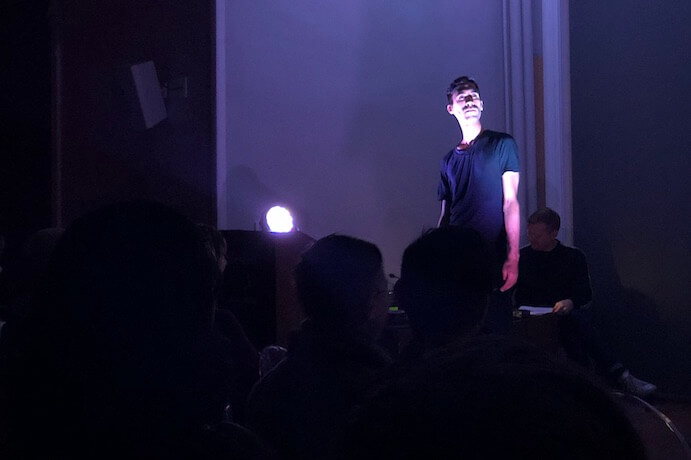Gabriel Dharmoo, an artistic polyglot whose work exists at the nexus of avant-garde vocal music, ethnomusicology, and political performance, spilled his magic all over the small platform stage at Columbia University’s Maison Française on Thursday, November 21, 2019. His Anthropologies Imaginaires (“Imaginary Anthropologies”) is an extraordinary one-man show that simultaneously dazzles the audience and satirizes ethnomusicological research and discourse.
A collegial and anticipatory atmosphere filled the air at Maison Française. Composition students, performers, musicologists, French students, and curious locals awaited the intimate presentation. Around 8:10, the lights went dark, and then blue as Dharmoo slithered onto stage, miming disorientation, blinking, and seemingly trying to locate himself. He began to intone short, high, mellifluous and wordless phrases.
Behind him, a screen lit up with the words “Prayer of Invocation” / “Prière d’invocation” which seemed a more than fitting explanation for what he was doing. But this was not only a programmatic title–it was also a chapter of a documentary featuring interviews with ethnomusicologists that played behind Dharmoo throughout the performance. “The human voice,” one ethnomusicologist said passionately, “is the carrier of culture and identity…vocal music has always revealed the colorful fragrances of a people.”
Gabriel Dharmoo–Photo by Jonathan Goulet
Dharmoo cycled through the vocal traditions of about a dozen different “tribes” while the ethnomusicologists on the screen behind him described, in purple prose, the results of their studies of each corresponding group. There was no prologue, abstract, or overview to the documentary, so while the audience was wildly entertained by Dharmoo’s outstanding range of vocal capabilities, one began to wonder what the running thread was between all of these groups. Gradually, though, Dharmoo introduced humor to poke holes in his fourth wall. After the lip, tongue, and teeth clicks of “Bruits de Bouche: Kschâhich/Microcosm of Insects” and “Dzendew’s” chest pumps combined with yodeling and voice cracks, like a macho-hurdy gurdy, we descended into the “Webörglez,” a group described as having a “12 tone, communal, equal” communicative practice. The explicit Schönberg reference reframed the entire performance for me, taking me out of Dharmoo’s spell and back to the program notes: his title “Imaginary Anthropologies” suddenly took on a literal tone, and I realized these groups were made up and the documentary was a mockumentary.
From there, Dharmoo’s license to entertain us took over. The “Sviljiains” involved Dharmoo taking water from a bowl and explosively spitting it out–not enough to reach the audience, but in a way that evoked the expulsion of demons. “Chant aquatique” provided immediate relief in which Dharmoo sang into the water: a bubbly bird-like falsetto. He turned back on the theatrics for the “Sariêh,” which included three-voice-part audience participation, and Dharmoo as the “égoiste” master, calling out each group’s lines in visceral declamations. This devolved into the “Élélè,” a parody of something in between country and musical theater, and the clenched-teeth humming of the “Girrhu” provided a smooth denouement.
Anthropologies imaginaires (Trailer) – Gabriel Dharmoo from Gabriel Dharmoo on Vimeo.
After the show wrapped to a gleeful applause, Dharmoo returned to the stage for a brief Q&A session. His rather hushed, thoughtful nature was disarming, standing in stark contrast to the kaleidoscope of larger-than-life characters he had just introduced us to. Appropriately, then, he described his desire to play games with the audience, through deception and pushing at the “limitations of genre,” a driving force behind his creation. Of particular intrigue was the way he discussed how audience responses to Anthropologies Imaginaires varied across the globe. Whereas laughter usually came, at various points, at the American shows, in Europe he sensed more equivocation. Dharmoo noted, “I’m taking advantage of my own mixed background or cultural ambiguity” in this piece, and while tackling the power dynamic between the imaginary peoples and the imaginary ethnomusicologists was intended to stir discomfort and humor, he also commented that avant-garde thinking about sound is “acultural.”
Just as Anthropologies Imaginaires is hard to categorize, Dharmoo is not prescriptive in his self-analysis. As he radically liberates himself from the confines of traditional vocal technique, he also seems to see his work as a moving target: somewhat flexible based on the audience; playful, yet posing serious questions. Self-described as a composer, vocalist, improviser and researcher, Dharmoo’s practice accordingly delights in the inbetweens. It appears to be in search of that sweet spot of foundation and risk that keeps many an artist challenged. “I like danger, but I like it on the line,” he noted.

